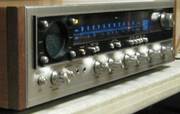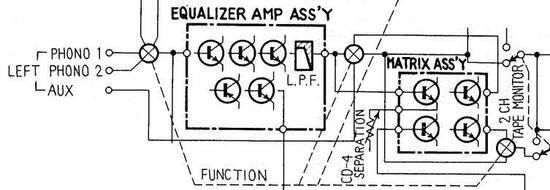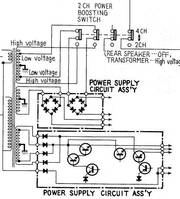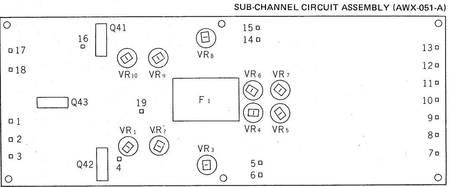Lange gesucht und durch Zufall gefunden :
"QX-939-ART-006-0 - MANUAL 02-1973"
Dies ist die reduzierte Variante des englischen 1973er Service- Manuals, weil uns hier weder FM noch AM noch Endstufen interessieren. Hier geht es um die Technik der 3 Quadro Systeme in einem Verstärker / Receiver und die aktuellen Varianten des QX-949 sowie die Details und Hintergründe.
.
QX-939-ART-006-0 - SERVICE MANUAL - QX-949 <73H02M41D>
AM/FM STEREO RECEIVER - FUW (also nicht die 949A-Version)
Hier folgt zwar das gesamte Inhaltsverzeichnis wegen der Beschreibungen, doch ein Teil der nicht ineressierenden Komponenten ist bewußt weggelassen !! (zurück zum Hauptartikel)
.
CONTENTS
| 1. | SPECIFICATIONS. | 2 |
| 2. | FRONT PANEL FACILITIES. | 5 |
| 3. | CONNECTION DIAGRAM. | 7 |
| 4. | BLOCK DIAGRAM. | 9 |
| 5. ------ | CIRCUIT DESCRIPTION | |
| 5.1 | RF Stage. | 11 |
| 5.2 | AF Amplifier. | 13 |
| 6. ------ | LEVEL DIAGRAM. | 15 |
| 7. ------ | DISASSEMBLY. | 16 |
| 8. ------ | PARTS AND P.C. BOARD LOCATION | |
| 8.1 | Top View . | 17 |
| 8.2 | Bottom View. | 18 |
| 9. ------ | DIAL CORD STRINGING . | 19 |
| 10. ------ | ALIGNMENT PROCEDURE | |
| 10.1 | Required Measuring Instruments. | 20 |
| 10.2 | AM Alignment. . | 20 |
| 10.3 | FM Alignment.i. | 20 |
| 10.4 | CD-4 Decoder Circuit Alignment. | 21 |
| 10.5 | Power Amplifier Adjustment. | 21 |
| 11. ------ | EXPLODED VIEW AND PARTS LIST | |
| 11.1 | Exploded View-1. | 23 |
| 11.2 | Exploded View-2. | 27 |
| 12. ------ | SCHEMATIC DIAGRAMS, P.C. BOARD PATTERNS AND PARTS LIST | |
| 12. 1 | Circuit Connection Diagram and Miscellaneous Parts . | 31 |
| 12. 2 | Tuner Assembly (AWE 027-0). | 36 |
| 12. 3 | Equalizer Amplifier Assembly (AWF-010-0). | 42 |
| 12. 4 | Sub-Channel Circuit Assembly (AWX-051-B) . | 47 |
| 12. 5 | Matrix Circuit Assembly (AWM-048-0). | 59 |
| 12. 6 | Decoder Circuit Assembly (AWM-031-0). | 63 |
| 12. 7 | Control Amplifier Assembly (AWG-023-0). | 68 |
| 12.8 | Power Amplifier Assembly (AWH-027-0) . | 73 |
| 12. 9 | Protection Circuit Assembly (AWM-049-A). | 78 |
| 12.10 | Switch Circuit Assembly (AWS-048-A). | 81 |
| 12.11 | Power Supply Circuit Assembly (AWR-038-0). | 85 |
| 13. ------ | PACKING METHOD AND PART NUMBERS. | 88 |
.
Hier ein Teil der Spezifikationen, insbesondere der Bestückung
| 1._SPECIFICATIONS____________ | ||
| SEMICONDUCTORS | ||
| FETs | 14 | |
| ICs | 7 | |
| Transistors | 118 | |
| Diodes | 69 | |
| Auf den ersten Fotos der 949 Ur-Version war nur ein IC zu erkennen, im Tuner Teil, hier werden 7 ICs gezählt, aber es ist noch nicht die 949-A Version | ||
| AMPLIFIER SECTION | ||
| Continuous Power Output | Quadro | |
| 20Hz - 20kHz (4 channels driven) | 40W x 4 (8 Ohm), 50W x 4( 4 Ohm) | |
| 1kHz (4 channels driven) | 44W x 4 (8 Ohm), 58W x 4 (4 Ohm) | |
| 1kHz (Each channel driven) | 53W/CH (8 Ohm), 75W/CH (4 Ohm) | |
| Continuous Power Output | (2CH. POWER BOOSTING SWITCH set at "2 CH") | |
| 20Hz - 20kHz (2 channels driven) | 60W+60W (8 Ohm), 75W+75W (4 Ohm) | |
| 1kHz (2 channels driven) | 65W+65W (8 Ohm), 85W+85W (4 Ohm) | |
| 1kHz (Each channel driven) | 75W/CH (8 Ohm) 100W/CH (4 Ohm) | |
| Power Bandwidth | ||
| (IHF, 4 channels driven) | 7Hz - 40kHz | |
| Input Sensitivity/Impedance | ||
| PHONO 1 | 2.5mV/50kft | |
| PHONO 2 | 2 5mV/50kft | |
| PHONO Overload Level (rms/p-p) | 100mV/280mV | |
| Frequency Response | ||
| PHONO (RIAA equalization) | 30Hz- 15kHz + 1dB | |
| PHONO | More than 70dB | |
| AUX, TAPE MON | More than 90dB | |
| CD-4 Demodulator Section | ||
| Input Sensitivity | 2.5mV (1 - 5mV adjustable) | |
| Input Impedance | 100kOhm | |
| Harmonic Distortion | 0.07% | |
| Signal-to-Noise Ratio | ||
| (IHF, A Network) | More than 70dB | |
| Separation (STD Test Signal at 1kHz) | ||
| Left- Right | 50dB | |
| Front - Rear | 30dB | |
| 20Hz - 15kHz | ||
| MISCELLANEOUS | ||
| Built-in CD-4 Demodulator, | Regular Matrix Decoder, SQ Matrix Decoder | |
| Power Requirements . | . AC 120V 60Hz or 110, 120V, 130V, 220V and 240V (Switchable) 50/60Hz | |
| 250W (UL approved model only) | ||
| 530W (5-line Voltage model only) | ||
| Abmessungen | 550(W) x 160(H) x 440(D)mm | |
| Weight: Without Package | 22.4 kg =49 lb 5 oz | |
| 27.2kg 59 lb 14 oz |
Was fällt hier bereits auf ?
Wir müssen die propagierten super tollen Qualitäten des ganz normalen Audio- Verstärkerteils definitiv trennen von den Qualitäten / Spezifikationen des Phono-Entzerrer-Vorverstärkers und der Quadro-Vorstufen.
Die Entwickler-Spezifikation von CD-4 begrenzt die Bandbreite schon von der Theorie her auf 15 kHz - für alle Kanäle !!, also auch die Front-Kanäle. Hatte mir Herr Brüggemann in seinem Platteschneidstudio gezeigt, daß er keine Frequenzen oberhalb von 18 kHz auf die Neumann- Schneidemaschine läßt, also alles mit 18 db/Okt. "absägt", wird bei Quadro Platten allgemein, also auch bei QS und SQ bei 15 kHz alles (weg-) gefiltert. Die eventuellen Mischfrequenzen könnten die Phasenauflösung der hinteren Kanäle empfindlich stören.
Man kann das ganz simpel nachrechnen. Die CD-4 Trägerfrequenz von 30 kHz wird mit 15 kHz nach unten und 15 kHz nach oben "moduliert". Damit bleiben für die Stereo-Information eben nur noch 40Hz bis 15 kHz übrig.
Und damit auf die beiden Frontkanäle auch nichts Unerlaubtes drauf kommt, hat der QX-949 Entzerrer-Vorverstärker dort ein "Low Pass" Filter am Ausgang.
.
5.2 AF (= Audio Frequency) AMPLIFIER
Equalizer stage (wir nennen das den Phono- Entzerrer- Vorverstärker)
The equalizer amplifier comprises 5 transistors; in each channel. Three of these operate as a negative feedback type equalizer amplifier to obtain standard RIAA equalization characteristics.
.
WICHTIG : Hier steht es explizit : The other two form a buffer amplifier (sie (bilden einen Impedanzwandler), which supplies the CD-4 subcarrier signal (das sind die 30 kHz) to the sub-channel assembly.
After phono equalization, the signal passes through a low pass filter and thence to the matrix assembly. The purpose of this low pass filter is to prevent leakage of the supersonic subcarrier signal of CD-4 discs into the main signal path.
Sub-channel (CD-4) demodulator
The subcarrier signal from a CD-4 record first passes through the carrier level control and enters the sub-channel assembly. This subcarrier is a 30kHz signal frequency-modulated with front-minus-rear difference information.
Demodulation takes place in a PLL (Phase Locked Loop) circuit. The resulting audio signal then passes through the ASC (Automatic Sensitivity Control), sub-equalizer and muting circuits, and thence through the ANRS (Automatic Noise Reduction System) circuit to the matrix circuit.
Matrix circuit (in CD-4 signal path)
The main CD-4 signal (from the equalizer) and the sub-signal (from the CD-4 sub-channel assembly) are added and subtracted in a series of algebraic operations to obtain four independent channel signals.
This is done in the matrix circuit. Different phono cartridges produce different output voltages and, therefore, main signals of different levels. The sub-signal, however, being FM modulated, does not vary in level (after demodulation, of course). To obtain optimum channel separation in the matrix operation, the main and sub-signals must therefore be first matched in level.
This is done by the separation control on the front panel which regulates the main signal level. It controls the amount of negative feedback current at the transistor's emitter.
RM, SQ decoder circuits RM (Regular matrix)
The signal from the equalizer (Vorverstärker) enters the decoder assembly, if the MODE switch is at RM or SQ position. The decoder comprises two phase shifters and a matrix circuit. By changing the position of the MODE switch, the decoder can be made to operate according to the RM or SQ system.
Control amplifier (Lautstärke und Klangregler)
The control amplifier is a negative feedback circuit comprising one FET and two transistors. To obtain stable operation, this two-stage direct coupled circuit constitutes a buffer amplifier of high input impedance but low output impedance.
Power amplifier and protection circuit
The power amplifier is basically an all-stage direct coupled pure complementary design. Power supply is of course of the balanced positive and negative type.
With the mode switch in 2CH position, the rear channel inputs are grounded, only the front channel inputs remain operative. The protection circuit incorporates 4 transistors (one for each channel) for four channels, which are used to detect overload.
DC potential at the junction points of the output stage transistors is done by a differential amplifier consisting of two transistors. Additionally, three transistors are used to drive the cut-off relay. At the first sign of trouble, the relay contacts are opened to safeguard the output transistors and speakers. The protector circuit also serves as a muting circuit, keeping the unit silent during the first few seconds after switch-on.
.
2-channel power boosting circuit
When the power boosting switch on the rear panel is set at "2CH," the output stages will operate in 2-channel mode, regardless of the position of the MODE switch. At the same time, power supply for the front channels only is switched to other taps on the power transformer, supplying a higher voltage to the power amps. As a result, available output power (per channel) in 2-channel operation is approximately twice that of 4-channel operation.
- Anmerkung : Das bedeutet, die maximale Leistung der 2 oder 4 Endstufen ist auch von der Leistungsabgabe des Netztrafos begrenzt.
4-channel level indicators
An indicator is provided for each channel. The length of the bright line varies according to the output level of each channel, giving a kind of display effect.
Its operating principle is as follows: A shutter is moved in accordance with the current flowing through a moving coil. This current is obtained from the power amplifiers. Output from the power amplifier is divided, and one portion is rectified. The resulting DC current flows through the indicator coil, moving the shutter. The above-mentioned voltage division is effected by the indicator level switch.
To protect the indicator coil against possible overload, two diodes are shunted in the circuit, operating as a limiter.
.
Hier noch ein paar der Bezeichnungen, die öfter refrenziert werden
8. PARTS AND P.C. BOARD LOCATION / 8.1 TOP VIEW (Aufsicht von oben)
MATRIX CIRCUIT ASSEMBLY AWM-048-0
DECODER CIRCUIT ASSEMBLY AWM-031-0
8.2 BOTTOM VIEW (Ansicht von unten)
SUB-CHANNEL CIRCUIT ASSEMBLY AWX-051-B
10. ALIGNMENT PROCEDURE
10.1 REQUIRED MEASURING INSTRUMENTS (die Meßgeräte)
• FM Signal generator
• MPX signal generator
• AM signal generator
• Millivolt meter
• Distortion meter
.
(Hier wird es komplex, weil es 10 Trimmpotis gibt) :
10.4 CD-4 DECODER CIRCUIT ALIGNMENT (= Justage)
In der Übeschrift ist eine Vertauschung, es ist eben kein DECODER, es ist ein Demodulator !!
- When the PLL demodulator integrated circuit has been replaced (Q41, Q42: SL60505), adjustments should be made in the following order.
- This method is both convenient and simple, but, if carried out carefully, is capable of adjustment over the practical range.
.
Note, however, that unless the test record (PQX-1011) and the phono cartridge used for the audition are both new, adjustment is impossible. (Beachten Sie jedoch, dass eine Anpassung nicht möglich ist, es sei denn, die Testaufzeichnung (PQX-1011) und das für das Audit verwendete Abtastsystem sind beide neu. - Muß man das verstehen ?)
- Terminal 19 of the sub-channel assembly must be to ground. (This ensures that muting is inactivated.)
- Connect an oscilloscope to terminal 14 (L channel). (For the R channel use terminal 5.)
- Turn the carrier level control up to its maximum (fully clockwise).
- Play band 1 of the test record (Band 2 for the R channel). The warble-tone waveform will be displayed on the oscilloscope.
- Turn the carrier level control to the left until the point where the warble-tone waveform distorts is reached. This adjustment is extremely critical, and should be performed with great care.
- Adjust VR10 until the warble-tone distortion disappears. (For the R channel use VR1.)
It is preferable for the adjustment to be made with the lowest possible carrier level, so the oscilloscope used should have as high a vertical sensitivity as possible (approximately lOmV/cm).
.
Hilfreich sind die genauen eindeutigen Bezeichnungen der einzelnen verbauten Platinen
| Description | Part No. |
| Tuner assembly | AWE-027-0 |
| Equalizer amplifier assembly ------ (Phono Vorverstärker | AW F-010-0 |
| Control amplifier assembly ----- (Filter/Klangregler) | AWG-023-0 |
| Decoder circuit assembly -------(QS) | AWM-031-0 |
| Sub-channel circuit assembly ------(CD-4) | AWX-051-B |
| Matrix circuit assembly -------(Matrix-Pegel) | AWM-048-0 |
| Protection circuit assembly | AWM-049-A |
| Power amplifier assembly | AWH-027-0 |
| Headphone jack assembly | AWX-054-0 |
| Switch circuit assembly | AWS-048-A |





